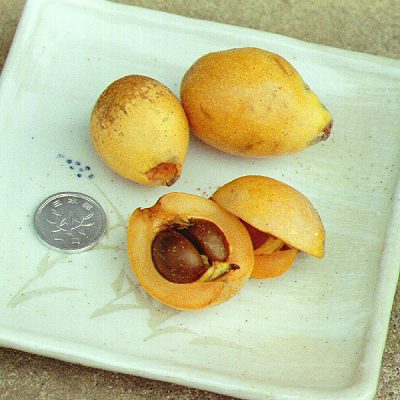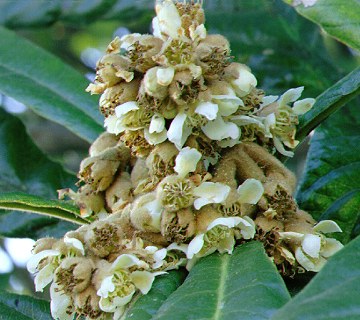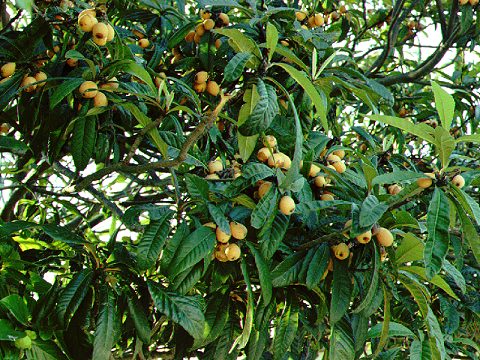BiwaEriobotrya japonica (Thunb.) - Loquat
Fruit on the tree (2000-07-04)
|
|
I suppose I was aware of the existence of this fruit, but I'd never noticed the tree until sometime in June (2000), when on the way to the station I passed a group of people systematically stripping the tree in front of their house of its plentiful fruit. They simply shook branches violently, and caught as much as they could. So eventually I got round to taking a few photos, and wrote an entry for jeKai. Here's my slightly drier "dictionary style"...
 The fruit (a one-yen coin is 2 cm in diameter) |
This tree is native to southeastern China and possibly the southern end of Japan, but it is widely cultivated. The tree is evergreen, with distinctly ribbed leaves, and grows to 5 or 10 metres high. The fruit, also easily available in Japanese supermarkets, is small (3 or 4 cm long), pale tangerine-coloured, and pear-shaped, sometimes with a single almost spherical stone in the centre (1 cm dia.), other times with two or three. The taste is quite delicate, but distinctive, with a pleasant tartness. (The kernels are said to be poisonous if cracked open and eaten in large quantities.)
As usual, the only really reliable non-local way to identify a plant is by its Latin name. The "Thunb." given at the end, by the way, is after Thunberg, though the plant was first described to the West by his predecessor Kaempfer. In English these are most commonly known as "loquats", which is mercifully less of a mouthful than "Eriobotrya". Other names I found include "Japanese medlar" and "Japanese plum", but "plum" in particular is usually used for ume, which in turn can also be called "Japanese apricot", which is odd, since I'd say that the biwa is much more similar to an apricot than ume. Anyway, call it a loquat - this name comes from Cantonese, southern Chinese, from the tree's source. According to my Japanese-Chinese dictionary (I'm not a Chinese speaker), the Mandarin name is pipa, with the same characters as the Japanese name, whereas the Cantonese luh kwat is written with entirely different characters.
 "A pile of profiteroles" |
 An unusual sense of timing
An unusual sense of timing
The flowers arrive at an odd time, in early winter, leaving the coldest part of the year for the fruit to set. They are rather exotic, in an inconspicuous sort of way, most closely resembling a pile of profiteroles before adding the chocolate sauce.
(Photo: 2000-12-05 - same tree as top photo)
![]()
Links
My jeKai entry for Biwa - a little more about the names, if you can read kanji
A very detailed web page on loquats at Purdue University

